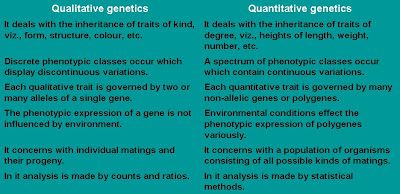The phenotypic traits of the different organisms may be of two kinds, viz., qualitative and quantitative. The qualitative traits are the classical Mendelian traits of kinds such as form (e.g., round or wrinkle seeds of pea); structure (e.g., horned or hornless condition in cattles); pigments (e.g., black or white coat of guinea pigs); and antigens and antibodies (e.g., blood group types of man) and so on. We have already discussed in previous chapters that each qualitative trait may be under genetic control of two or many alleles of a single gene with little or no environmental modifications to obscure the gene effects. The organisms possessing qualitative traits have distinct (separate) phenotypic classes and are said to exhibit discontinuous variations.
The quantitative traits, however, are economically important measurable phenotypic traits of degree such as height, weight, skin pigmentation, susceptibility to pathological diseases or intelligence in man; amount of flowers, fruits, seeds, milk, meat or egg produced by plants or animals, etc. The quantitative traits are also called metric traits. They do not show clear cut differences between individuals and forms a spectrum of phenotypes which blend imperceptively from one type to another to cause continuous variations.In contrast to qualitative traits, the quantitative traits may be modified variously by the environmental conditions and are usually governed by many factors or genes (perhaps 10 or I00 or more), each contributing such a small amount of phenotype that their individual effects cannot be detected by Mendelian methods but by only statistical methods.
Such genes which are non-allelic and effect the phenotype of a single quantitative trait, are called polygenes or cumulative genes. The inheritance of poly genes or quantitative traits is called quantitative inheritance, multiple factor inheritance, multiple gene inheritance or polygenic inheritance. The genetical studies of qualitative and quantitative traits are called qualitative genetics and quantitative genetics, respectively. The major differences between the two are following :
Certain Characteristics of Quantitative Inheritance -
The quantitative inheritance have following characteristics:
1. The segregation phenomenon occurs at an indefinitely large number of gene loci.
2. If a substitution of a allele occurs in a gene locus then such allelic substitutions have trivial effects.
3. The genes for a multiple trait have different biochemical functions but similar phenotypic effects, therefore, the phenotypic effects of gene substitutions are interchangeable.
4. Blocks of genes are bound together by inversions and transmitted as units from inversion heterozygotes to their progeny, but such blocks are broken up by crossing over in insersion homozygotes.
5. The polygenes have pleiotropic effects; that is, one gene may modify or suppress more than one phenotypic trait. A single allele may do only one thing chemically but may ultimately affect many characters.
6. The environmental conditions nave considerable effect the phenotypic expression of poly genes for the quantitative traits. For example, height in many plants (e.g., corn, tomato, pea, marigold) is genetically controlled quantitative trait, but some environmental factors as soil, fertility, texture, and water, the temperature, the duration and wavelength of incident light, the occurrence of parasites, etc., also affect the height. Similarly, identical twins with identical genotypes, if grow up in different kinds of environments, show different intelligence quotients.










0 comments:
Post a Comment